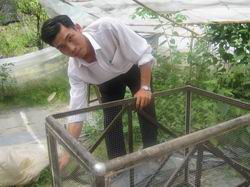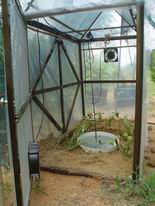A student from the University of Agriculture and Forestry has developed an automatic temperature sensing system. This system helps automatically adjust the temperature and humidity for the nursery.
 |
Vo Van Chinh is assembling the aluminum frame for the greenhouse model equipped with the automatic temperature sensing system. |
From now on, home gardeners will no longer need to spend excessive effort on plant care.
A student at the University of Agriculture and Forestry in Ho Chi Minh City has just created a temperature sensing system to monitor and automatically adjust the temperature in plant gardens, especially ornamental flowers in the nursery.
The system has a simple structure but high effectiveness, including a temperature relay, an exhaust fan, and an intake fan connected in a circuit.
Vo Van Chinh designed his automatic temperature sensing nursery model using a lightweight aluminum frame with dimensions of 1.2m x 0.6m x 0.8m. To ensure the necessary conditions for plants to exchange air and perform photosynthesis, all sides of the frame are covered with white nylon paper. This way, the nylon separates the internal temperature and humidity from the external environment without affecting the plants’ photosynthesis.
The principle of operation for this system is that when the temperature exceeds a certain limit, the relay will close the circuit. At this point, both fans will operate to create ventilation.
 |
The internal structure of the automatic temperature sensing model serves the production of cuttings and seedling propagation. |
The intake fan is placed below to push air into the greenhouse, while the exhaust fan is located above on the opposite side to pull air out.
This function helps circulate the air inside the frame, creating favorable conditions for plants to perform gas exchange and maintain an appropriate temperature.
Meanwhile, the pump will spray mist to increase humidity. Consequently, the temperature inside the greenhouse will drop.
This automatic temperature sensing system can control the temperature within the greenhouse and automatically increase humidity, positively impacting the productivity of plant propagation through cutting and seedling sowing methods.
Vo Van Chinh has tested the nursery with his automatic temperature sensing system on five types of plants: white sail plant, white leaf plant, string of pearls, five-color leaf plant, and medicinal plant.
Results showed that all five plant species thrived in the nursery with the automatic temperature sensing system.
According to student Vo Van Chinh, the nursery equipped with an automatic temperature sensing system will facilitate the introduction, hybridization, and improvement of imported plant varieties.
This way, it will be possible to cultivate many types of ornamental plants domestically with quality equivalent to that grown abroad, but at a lower cost.
Huong Cat



















































